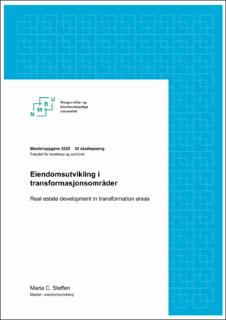| dc.contributor.advisor | Terje, Holsen | |
| dc.contributor.author | Steffen, Maria Christine | |
| dc.coverage.spatial | Norway, Oslo | en_US |
| dc.date.accessioned | 2021-01-02T16:40:26Z | |
| dc.date.available | 2021-01-02T16:40:26Z | |
| dc.date.issued | 2020 | |
| dc.identifier.uri | https://hdl.handle.net/11250/2721185 | |
| dc.description.abstract | Byutviklingen i Oslo kommune utspiller seg hovedsakelig gjennom fortetting, i form av områdetransformasjon og byomforming. Det var med dette ønskelig å undersøke utviklingsforholdene innenfor dagens byutviklingspraksis, og oppgavens overordnede tema omhandler derfor eiendomsutvikling i transformasjonsområder. I de senere årene har vi i tillegg vært vitne til en endring i bruken av styringsverktøy i Oslo, herunder endret bruk av eksisterende plantyper med hjemmel i plan- og bygningsloven, og tilskudd av nye plantyper utenfor plan- og bygningslovens. Dette har ført til at rammene for dagens byutviklingspraksis både avklares gjennom formelle og uformelle arealplaner, og at flere områder i Oslo kommune utvikles med utgangspunkt i ulike former for styringsverktøy. Med utgangspunkt i dette var det ønskelig å se nærmere på hvor godt egnet de ulike styringsverktøyene er til å styre utviklingen av enkeltprosjekter i et transformasjonsområde, med fokus på effektivitet, forutsigbarhet og fleksibilitet. Oppgaven bygger på et casestudie av tre transformasjonsområder i Oslo, representert ved totalt seks eiendomsutviklingsprosjekter, herunder to innenfor hvert av områdene. Transformasjonsområder er utbredt i Oslo, og for å besvare oppgavens problemstilling, vil styringsverktøyet, som legger rammene for utviklingen innenfor området, utgjøre variabelen som skiller områdene fra hverandre. Med utgangspunkt i Oslo kommunes overordnede mål om en rask og effektiv plan- og byggesaksbehandling, gjennomføres det i tillegg en sammenligning av tidsbruken og konfliktnivået i reguleringsprosessene til de ulike områdene. Resultatene peker på at både eksterne forhold tilknyttet styringsverktøyene og prosjektinterne forhold har vært utslagsgivende på variablene som har målt effektivitet, konfliktnivå, forutsigbarhet og fleksibilitet. Det har videre vist seg å være en sterk korrelasjon mellom tidsbruk og antall høringsrunder, hvor behovet for flere høringsrunder ofte var et resultat av endringer i plangrepet på bakgrunn av interessemotsetninger, endrede forhold tilknyttet styringsverktøyet, nye grep for området og justeringer opp mot rammene styringsverktøyene fremstiller. Variablene som reflekterer konfliktnivået, har i likhet med tidsbruket, vært høyest på Skøyen, etterfulgt av Ensjø og Løren, og mye har tydet på at konfliktnivået på Skøyen ikke var en direkte konsekvens av styringsverktøyet i seg selv, men heller et resultat av manglende styringsgrep i tråd med fremtidig utvikling og prosjektinterne beslutninger. | en_US |
| dc.description.abstract | The urban development practice in Oslo mainly takes place through transformation and densification in existing built-up areas. The main goal for thesis is to illustrate the development conditions within today ́s urban planning practice, and the overall theme will concern transformation of areas. In recent years, we have also witnessed a change in use of land-use planning tools in Oslo, including a changed use in existing formal land-use planning tools, and addition of new plans in the informal land use planning tools. This has led to a practice where both formal and informal land use plans are being used to clarify the framework and visions of development in areas, and that several areas in the City of Oslo are being developed based on various forms of plans. Based on this, the thesis will study how suited the various land-use planning tools are to manage the development of individual projects in a transformation area, focusing on efficiency, predictability and flexibility. This thesis is based on a case study of three transformation areas in Oslo, represented by a total of six development projects, hereby two within each area. Transformation areas are common in Oslo, and the land-use planning tools, which sets the framework for development within the area, will correspond as the variable that separates the areas from each other. Based on the Oslo municipality's overall goal of a quick and effective planning and construction proceeding, there will also be a comparison of the time usage and level of conflict within the projects regulation processes for the various areas. The results indicate that both external conditions associated with the land-use planning tools and project internal relationships have made a difference on the variables that has measured efficiency, conflict level, predictability and flexibility within the projects. There has also been a clear correlation between time spent and the number of hearings in the regulation process. It also shows that a requirement for more hearings often was a result of changes in proposed development plan based on conflicts of interest, changed conditions associated with land-use planning tool, new grasps for the area and adjustments to the framework the land-use planning tools represent. The variables that reflect the level of conflict, like time usage, have been highest in the area of Skøyen, followed by Ensjø and Løren, and several factors has indicated that the level of conflict on Skøyen was not a direct consequence of the land-use planning tools itself, but rather a result of lack of control measures in line with future development of the area and project internal decisions. | en_US |
| dc.language.iso | nob | en_US |
| dc.publisher | Norwegian University of Life Sciences, Ås | en_US |
| dc.rights | Attribution-NonCommercial-NoDerivatives 4.0 Internasjonal | * |
| dc.rights.uri | http://creativecommons.org/licenses/by-nc-nd/4.0/deed.no | * |
| dc.subject | Transformasjonseiendom | en_US |
| dc.subject | Eiendom | en_US |
| dc.subject | Reguleringsprosess | en_US |
| dc.subject | Styringsverktøy | en_US |
| dc.subject | Forhandlinger | en_US |
| dc.subject | Plansystem | en_US |
| dc.title | Eiendomsutvikling i transformasjonsområder | en_US |
| dc.title.alternative | Real estate development in transformation areas | en_US |
| dc.type | Master thesis | en_US |
| dc.description.version | submittedVersion | en_US |
| dc.subject.nsi | VDP::Samfunnsvitenskap: 200 | en_US |
| dc.source.pagenumber | 90 | en_US |
| dc.description.localcode | M-EUTV | en_US |

